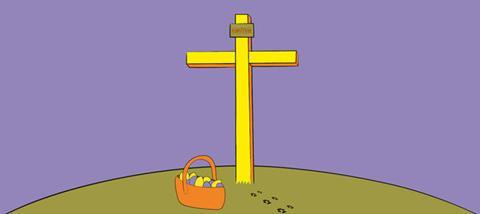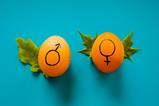The Easter story can be a difficult one for children. Ed Drew shares a few thoughts about how to explore it together at home

Explaining the Easter story to children is a particular challenge, as their heads are usually full of bunnies and chocolate eggs. Meanwhile, we are wondering how to tell them about the bloody death of a naked man on an indescribably brutal torture device. There is potential for disappointed expectations.
My dad still remembers the time his teacher demonstrated to his class the cause of death by crucifixion. A boy was held aloft by his outstretched arms until he no longer had the strength to raise his diaphragm to breathe and his face started to change colour. It made quite an impression on my dad, and presumably on the little boy who feared he might go the same way as the Messiah. Times have changed. Completely. Thankfully. There are other, better and safer ways to teach children about the events and meaning of Easter. Let’s run through some essentials for teaching children about the first Easter at home.
Join the party
Easter eggs and hot cross buns arrived in our supermarkets just as Christmas puddings were being sold off at half price. By Easter weekend, many children across the land will have been given more chocolate eggs than they can carry. As at Christmas, we have the reason for the season, let’s not keep it from our children. We can celebrate Easter enthusiastically, engaging all of our – and our children’s – senses. How you do that is up to you and your family, but here are a few ideas to get you started:
Make pitta bread with your children (search ‘pitta bread recipe kids’) to taste the unleavened bread Jesus broke during the Last Supper (Luke 22:19).
Eat a meal just as Jesus ate his Last Supper by lying on your side on cushions on the floor at a low table (Luke 22:14).
Wash each other’s feet to remember how Jesus got ready for Easter (John 13:1-5).
When you’re in the park or garden, throw a stone (not at anybody!). Jesus prayed a stone’s throw away from his disciples (Luke 22:41).
Go to Google Earth and look at Jerusalem as it is today. Search for the Garden of Gethsemane (the one in Jerusalem, not Arizona) and the garden tomb.
Google ‘Caiaphas’ tomb’ to see a photo of the box found in 1990 that might well be the box Caiaphas’ bones were placed in. Caiaphas was the high priest who was in charge of the plan to have Jesus killed (Matthew 26:57). There is no box for Jesus’ bones!
Have any of you got any scars on your bodies? Do you remember how you got them? Can others see them and touch them? This is one of the ways Jesus proved to the disciples that it really was him (Luke 24:39).
The disciples gave Jesus a piece of fish cooked in a simple way to prove that he was the real, living Jesus (Luke 22:42). You can grill some fish with your children. Do they like the way it tastes?
Barbecue some fish on a fire. That was how Jesus cooked his friends’ breakfast after he rose from the dead (John 21:9-10). Fancy a barbecue for breakfast?
How high can you launch an object into the sky? You could use a catapult, a toy rocket or just a strong arm. The disciples watched as Jesus rose up into heaven. They celebrated and sang because they knew that he was going to heaven to rule over them for ever (Luke 24:50-53).
It is an oddity that death is the only certainty in our children’s lives, yet no one ever talks to them about it
Tread carefully
There is no need to shock children with the horrendous floggings, humiliation and death Jesus suffered. None of it will help them understand Easter better. Children do not engage emotionally in the same way as adults. Instead, they need to be told the simple facts and explanation of the first Easter in an engaging way. For instance, we can helpfully say that Jesus died on a cross. There is no need to say that he was nailed to a cross or to use words such as killed, murdered or flogged. We are likely to be far more on edge about this than our children.
In the UK today, no one likes talking about death. It is an oddity that death is the only certainty in our children’s lives, yet no one ever talks to them about it. As their parents, we have the perfect opportunity at Easter to talk about death, and in the same breath to say that it doesn’t need to frighten us. We can explain that Jesus died so that our death could be a doorway to life for ever with him. Death is still sad, because we can no longer be with those we love. But to be with Jesus – the one we have been trusting each day – for ever, and with all the tears, pain and sadness gone is not sad. This is why Jesus died at Easter: to change the conversation about death.
Of course, every tiny detail of the resurrection can be laid out with reckless abandon! Tell your children at every opportunity that Jesus Christ came to life again, rolled back the vast stone, scared off the Roman guards and presented himself to hundreds of people. He was definitely dead, and now he is certainly alive. Every chocolate Easter egg speaks of the new forever life that Jesus Christ experienced and now offers to each child. Don’t let children eat vast quantities of chocolate this Easter without them knowing why it has all been crafted into eggs.
Explain forgiveness brilliantly
While the narrative of Easter is gripping, the meaning of Easter is life-changing. Let’s be creative, visual and engaging in how we explain and illustrate the effects of Jesus’ death and resurrection. For instance:
- The torn temple curtain shows how the crucifixion allows us to enter freely into God’s presence (Mark 15:38). Got some curtains you have been longing to replace? The moment has come for their final performance
- The swap that occurred on the cross (1 Peter 3:18) can be explained using a dirty T-shirt belonging to us and a clean T-shirt belonging to Jesus. At the cross, Christ died for my wrong attitudes, while I am given Christ’s perfect life, allowing me to walk into God’s family, as only Christ himself can.
- Christ dying as the final sacrifice in our place (Romans 3:25) can be visually demonstrated by putting one raw egg (Jesus) on top of another raw egg (you). When the cricket ball (of God’s fair punishment for our attitudes) drops down a gutter onto the eggs you are safe, while Jesus is smashed. It sounds traumatic, but you should hear the round of applause it gets!
Easter eggs speak of the new forever life that Jesus Christ experienced and now offers to each child
The first Easter is at the centre of all history. But it is not just history, it is personal. It is where Christ’s love for us is most clearly seen. It is in his death and resurrection that we have new life. He died and rose again for me! I need this! I want them to see that I need this, because they don’t often see me need anything. My children also need this. Perhaps there will be a moment in between the chocolate eggs to:
- List some of the common ways each of you sins against one another and God. Nail this list to a piece of wood and read Colossians 2:14 together.
- Make a cross out of wood and write “For…” and then a list of your names on it.
- Have a family ‘Last Supper’ using warm pitta bread and watered-down wine or grape juice. Repeat Jesus’ words from Luke 22:17-19.
Let’s join the Easter party, tread carefully and explain it brilliantly. We don’t even need to lose the fluffy bunnies and chocolate eggs to do so!



































